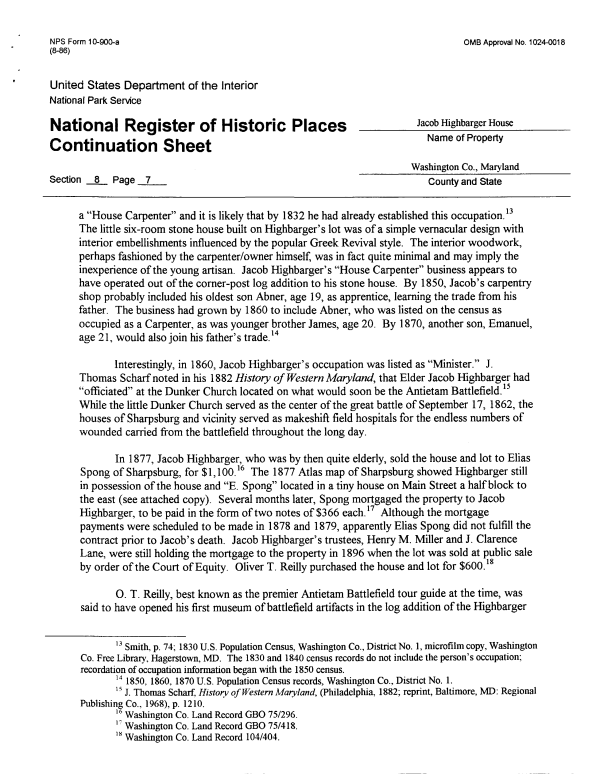 |
||||
|
DEPARTMENT OF HOUSING AND COMMUNITY DEVELOPMENT, MARYLAND HISTORICAL TRUST (Historic Sites Survey) var.d. MSA SE16-10 Image No: se16-10-0420 Enlarge and print image (74K) |
 |
||||
|
DEPARTMENT OF HOUSING AND COMMUNITY DEVELOPMENT, MARYLAND HISTORICAL TRUST (Historic Sites Survey) var.d. MSA SE16-10 Image No: se16-10-0420 Enlarge and print image (74K) |
| NFS Form 10-900-a OMB Approval No. 1024-0018 (8-86) United States Department of the Interior National Park Service National Register of Historic Places ___JacobHighbargerHouse___ r+ ,. .. —. • Name of Property Continuation Sheet Washington Co., Maryland Section 8 Page __7__ County and State a "House Carpenter" and it is likely that by 1832 he had already established this occupation.13 The little six-room stone house built on Highbarger's lot was of a simple vernacular design with interior embellishments influenced by the popular Greek Revival style. The interior woodwork, perhaps fashioned by the carpenter/owner himself, was in fact quite minimal and may imply the inexperience of the young artisan. Jacob Highbarger's "House Carpenter" business appears to have operated out of the corner-post log addition to his stone house. By 1850, Jacob's carpentry shop probably included his oldest son Abner, age 19, as apprentice, learning the trade from his father. The business had grown by 1860 to include Abner, who was listed on the census as occupied as a Carpenter, as was younger brother James, age 20. By 1870, another son, Emanuel, age 21, would also join his father's trade.14 Interestingly, in 1860, Jacob Highbarger's occupation was listed as "Minister." J. Thomas Scharf noted in his 1882 History of Western Maryland, that Elder Jacob Highbarger had "officiated" at the Dunker Church located on what would soon be the Antietam Battlefield.15 While the little Dunker Church served as the center of the great battle of September 17, 1862, the houses of Sharpsburg and vicinity served as makeshift field hospitals for the endless numbers of wounded carried from the battlefield throughout the long day. In 1877, Jacob Highbarger, who was by then quite elderly, sold the house and lot to Elias Spong of Sharpsburg, for $1,100.16 The 1877 Atlas map of Sharpsburg showed Highbarger still in possession of the house and "E. Spong" located in a tiny house on Main Street a half block to the east (see attached copy). Several months later, Spong mortgaged the property to Jacob Highbarger, to be paid in the form of two notes of $366 each.17 Although the mortgage payments were scheduled to be made in 1878 and 1879, apparently Elias Spong did not fulfill the contract prior to Jacob's death. Jacob Highbarger's trustees, Henry M. Miller and J. Clarence Lane, were still holding the mortgage to the property in 1896 when the lot was sold at public sale by order of the Court of Equity. Oliver T. Reilly purchased the house and lot for $600.18 O. T. Reilly, best known as the premier Antietam Battlefield tour guide at the time, was said to have opened his first museum of battlefield artifacts in the log addition of the Highbarger 13 Smith, p. 74; 1830 U.S. Population Census, Washington Co., District No. 1, microfilm copy, Washington Co. Free Library, Hagerstown, MD. The 1830 and 1840 census records do not include the person's occupation; recordation of occupation information began with the 1850 census. 14 1850, 1860, 1870 U.S. Population Census records, Washington Co., District No. 1. 15 J. Thomas Scharf, History of Western Maryland, (Philadelphia, 1882; reprint, Baltimore, MD: Regional Publishing Co., 1968), p. 1210. 16 Washington Co. Land Record GBO 75/296. 17 Washington Co. Land Record GBO 75/418. 18 Washington Co. Land Record 104/404. |